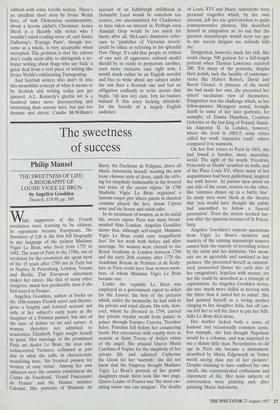The sweetness of success
Philip Mansel
THE SWEETNESS OF LIFE: A BIOGRAPHY OF LOUISE VIGEE LE BRUN by Angelica Goodden Deutsch, E19.99, pp. 380 Wile supporters of the French revolution were learning to be citizens, its opponents became Europeans. The Sweetness of Life is the first full biography in any language of the painter Madame Vigee Le Brun, who lived from 1755 to 1842. The toast of Paris in the 1780s, out of revulsion for the revolution she spent most of the 15 years after 1789 not in Paris but in Naples, St Petersburg, London, Vienna and Berlin. This European dimension makes her career, like that of many other emigrees, much less predictable than if she had stayed in France. Angelica Goodden, author of books on the 18th-century French novel and theatre, gives a lengthy and learned account not only of her subject's early years as the daughter of a Parisian painter, but also of the state of debate on art and nature. A woman, therefore not admitted to academies, Elizabeth Vigee taught herself to paint. Her marriage to the prominent Paris art dealer Le Brun, the man who rediscovered Vermeer, collapsed in part due to what she calls, in characteristic moralising tone, 'his frenzied passion for women of easy virtue'. Among her own admirers were the courtier connoisseur the Comte de Vaudreuil, 'Grand Fauconnier de France' and the finance minister Calonne. Her portraits of Madame du Barry, the Duchesse de Polignac, above all Marie Antoinette herself, wearing the new loose chemise style of dress, catch the striv- ing for simplicity fashionable in the fevered last years of the ancien regime. In 1788 Madame Vigee Le Brun organised a famous souper grec where guests in classical costume played the lyre, drank Cyprus wine and ate honey and raisin cake.
In its treatment of women, as in its social life, ancien regime Paris was more broad- minded than London. Angelica Goodden shows that, although self-taught, Madame Vigee Le Brun could earn 'magnificent fees' for her work both before and after marriage. No women were elected to the Royal Academy in London between 1768 and the early 20th century; after 1770 the Academie Royale de Peinture et de Sculp- ture in Paris could have four women mem- bers, of whom Madame Vigee Le Brun became one.
Under the republic Le Brun was employed as a government expert to select for the Louvre the best of the pictures which, under the monarchy, he had sold to his private and royal clients. His wife, how- ever, whom he divorced in 1794, carried her private royalist world from palace to palace through Europe: Caserta, Tsarskoe Seloe, Potsdam fell before her conquering brush. Her encounters with royalty were as ecstatic as Saint Teresa of Avila's vision of the angel. She praised Queen Maria Carolina of Naples for the simplicity of her private life and admired Catherine the Great for her `warmth'; she did not know that the Empress thought Madame Vigee Le Brun's portrait of her grand- daughters made them look like two pugs. Queen Louise of Prussia was 'the most rav- ishing vision one can imagine'. The deaths of Louis XVI and Marie Antoinette were personal tragedies which, by her own account, left her too grief-stricken to paint commemorative pictures. She described herself in emigration as 'so sad that the greatest misanthrope would seem too gay to me: society fatigues me, solitude kills me'.
Emigration, however, made her rich. She could charge 500 guineas for a full-length portrait when Thomas Lawrence received 200. Yet many of the portraits, despite their polish, lack the lucidity of contempo- raries like Hubert Robert, David and Baron Gerard. A prisoner of the world she had made her own, she presented her sitters' saccharine view of themselves. Emigration was the challenge which, as her fellow-painter Menageot noted, brought depth to some of her later portraits, for example, of Emma Hamilton, Countess Golovina or the last king of Poland, Stanis- las Augustus II. In London, however, where she lived in 1803-5, some critics called her work 'expensive trash'; others compared it to waxwork.
On her first return to Paris in 1801, she had found a harsher, more masculine world. The sight of the words 'Freedom, Fraternity or Death' scrawled on walls, and of the Place Louis XV, where many of her acquaintance had been guillotined, inspired her with horror. At parties men stood on one side of the room, women on the other, like 'enemies drawn up in a battle line'. So many men wore black at the theatre that 'you would have thought the public had assembled to follow a funeral procession'. Even the streets seemed nar- row after the spacious avenues of St Peters- burg.
Angelica Goodden's copious quotations from Vigee Le Brun's memoirs and mastery of the existing manuscript sources cannot hide the scarcity of revealing letters by the artist and her intimates. Her mem- oirs are as agreeable and sanitised as her pictures. She presented herself as calumni- ated, persecuted (hence the early date of her emigration), hopeless with money; yet her life could be described as a triumph of exploitation. As Angelica Goodden writes, she was 'much more skilful at moving with the times than it suited her to admit'. She had painted herself as a loving mother clinging to her daughter Julie, but off can- vas left her to sell her linen to pay her bills. Julie Le Brun died alone.
Her mother lacked both a sense of humour and occasionally common sense. For example, she had thought Napoleon would be a colossus, and was surprised to see a skinny little man. Nevertheless in old age in Paris she became a monument, described by Maria Edgeworth as 'better worth seeing than any of her pictures'. Despite claiming to have outlived her own epoch, she communicated enthusiasm and enjoyment of life. Her main subjects of conversation were painting and, after painting, Marie Antoinette.


























































 Previous page
Previous page